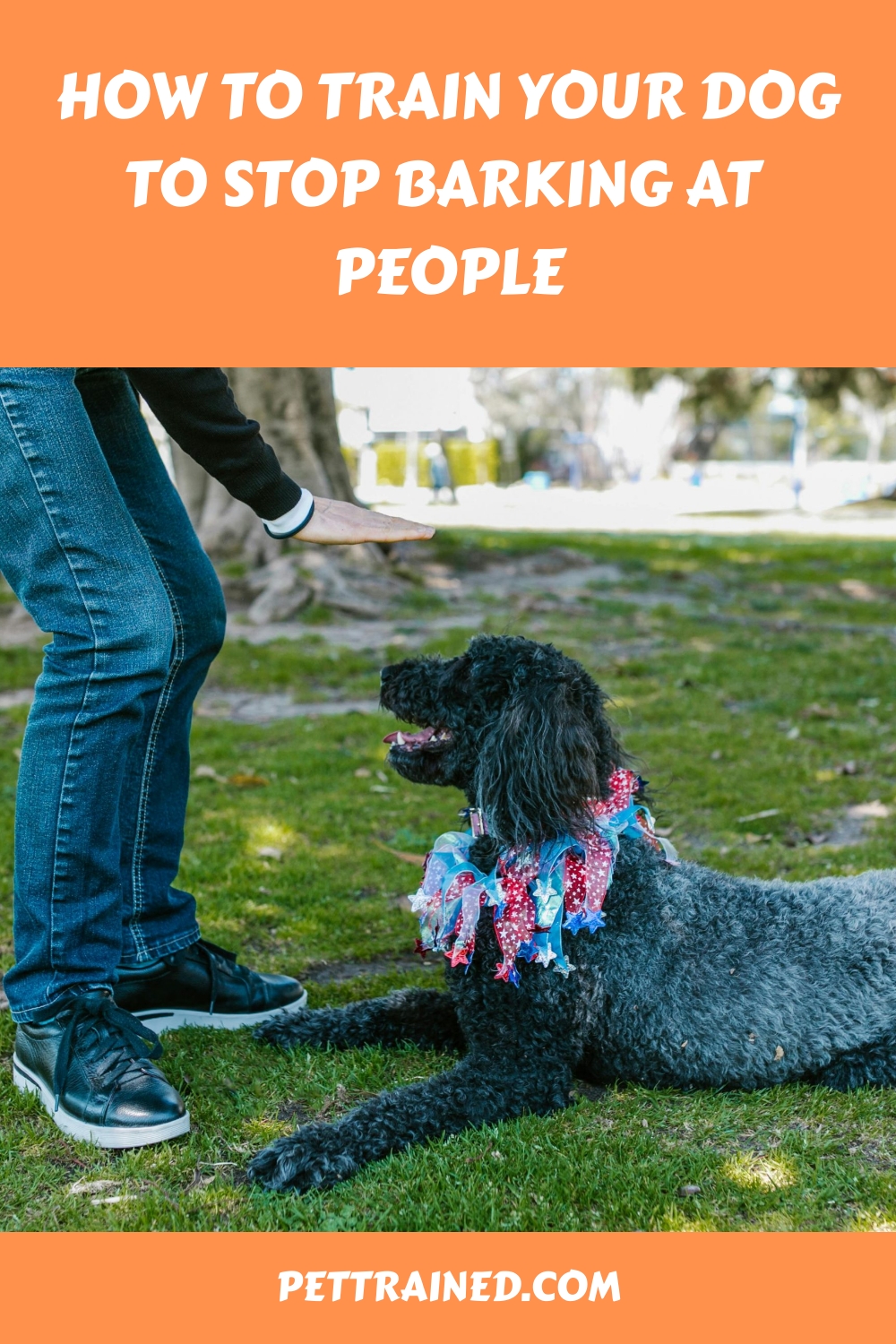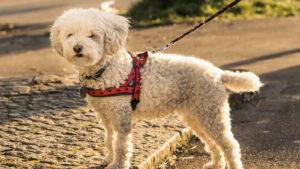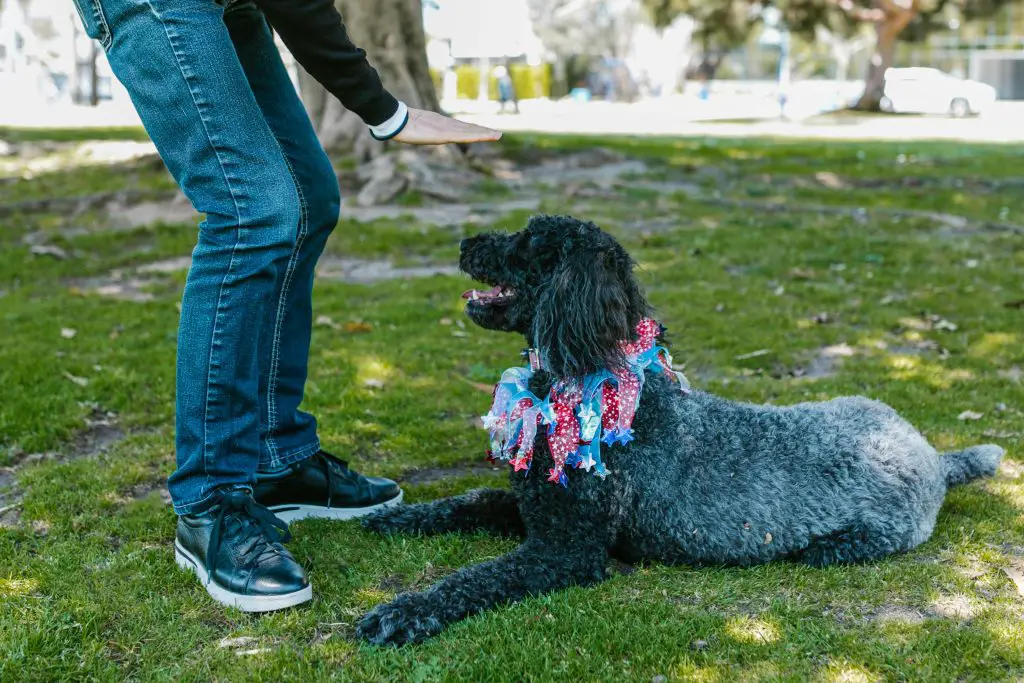
To train your dog to stop barking at people, start by identifying what triggers the barking. Early socialization is essential; expose your dog to various environments and people to reduce fear.
Use positive reinforcement, like treats or praise, to reward quiet behavior. Teach the ‘quiet’ command through consistent training sessions.
Manage the environment by removing stressors and providing mental stimulation with toys. Gradually desensitize your dog to people by controlled exposure and rewarding calm behavior.
If needed, seek help from a certified dog trainer. By implementing these strategies, you’ll foster better behavior and find more insights ahead.
Table of Contents
Key Takeaways

- Use positive reinforcement to reward calm behavior when your dog encounters people.
- Gradually expose your dog to people at a comfortable distance to build confidence.
- Redirect your dog’s attention with toys or treats before barking starts.
- Create controlled social interactions to manage and reduce barking triggers.
- Seek help from a certified dog trainer for a customized behavior modification plan.
Understand the Barking Triggers
To effectively train your dog to stop barking at people, you need to first identify what triggers their barking. Start by observing your dog’s behavior closely.
This post contains affiliate links. However all the information provided on this site are my own honest opinions. See more in Disclaimer.
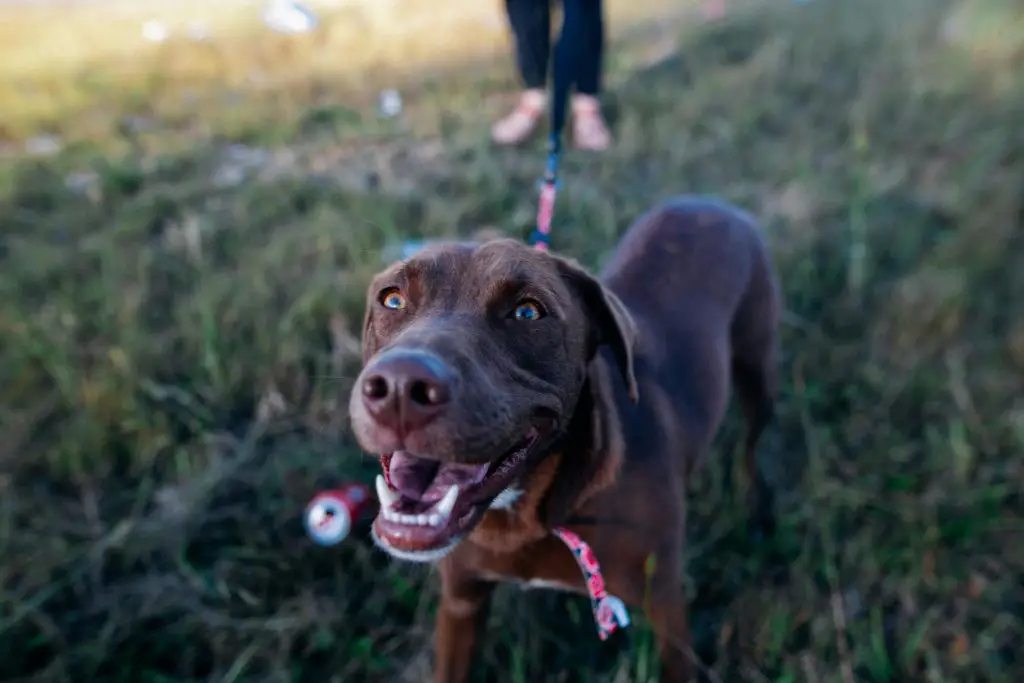
Pay attention to specific situations when the barking occurs. Is it when strangers approach your home, when someone new enters the room, or perhaps when your dog is on a walk?
Noticing these barking triggers is essential.
Next, focus on your dog’s body language. Dogs communicate a lot through their posture, tail position, and facial expressions.
Signs like a raised tail, stiff body, or wide eyes can indicate your dog is feeling threatened or anxious. Understanding these cues helps you gauge your dog’s emotional state and identify situations that cause fear or anxiety.
Once you’ve identified the triggers and understand your dog’s body language, you’re better equipped to address the underlying causes. Fear and anxiety are common reasons dogs bark at people.
Recognizing these emotions allows you to take appropriate steps to reduce your dog’s stress. This may involve creating positive associations with the trigger or desensitizing your dog gradually.
Consistent observation and understanding are your best tools to curb unwanted barking behavior.
Socialize Your Dog Early
Why is it necessary to socialize your dog early to prevent excessive barking at people?
Early socialization helps your dog become comfortable with various environments, people, and other animals.

Introducing your dog to new experiences during their formative months can greatly reduce fear-based barking later on.
Start by arranging puppy playdates. These gatherings provide a controlled setting where your dog can interact with other pups.
The positive interactions during these playdates will help your dog learn appropriate behavior and reduce anxiety around strangers.
Enroll your dog in socialization classes. These structured environments are excellent for exposing your dog to different stimuli in a positive way.
Trainers in these classes use positive reinforcement techniques, rewarding your dog for calm and friendly behavior. This method reinforces good habits and makes your dog less likely to bark excessively at people.
Early exposure to a variety of experiences is important. Introduce your puppy to different sounds, smells, and sights regularly.
Take them to parks, busy streets, and pet-friendly stores. Use treats and praise as positive reinforcement when your dog remains calm in these situations.
Teach the “Quiet” Command
To teach the ‘Quiet‘ command, establish consistent training sessions to guarantee your dog understands the cue.
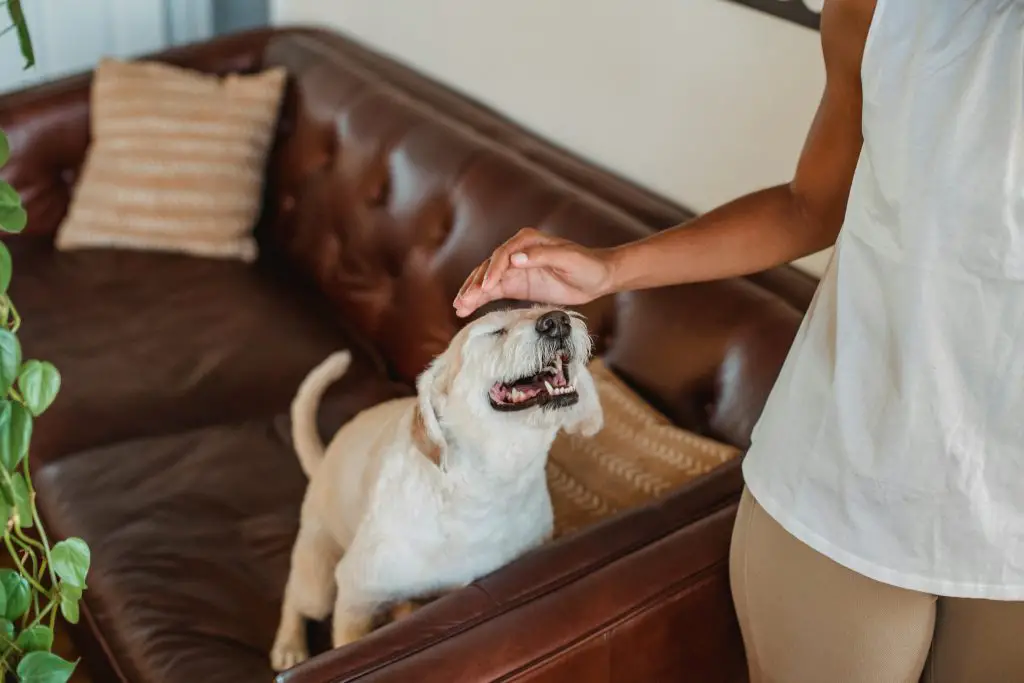
Use positive reinforcement techniques like treats or praise when your dog stops barking on command.
This approach helps your dog associate the command with a positive outcome, making it more likely they’ll respond appropriately.
Establish Consistent Training Sessions
Establishing consistent training sessions is essential for effectively teaching your dog the ‘Quiet’ command. Training consistency is key to behavior modification, as it helps your dog understand and retain what you’re teaching.
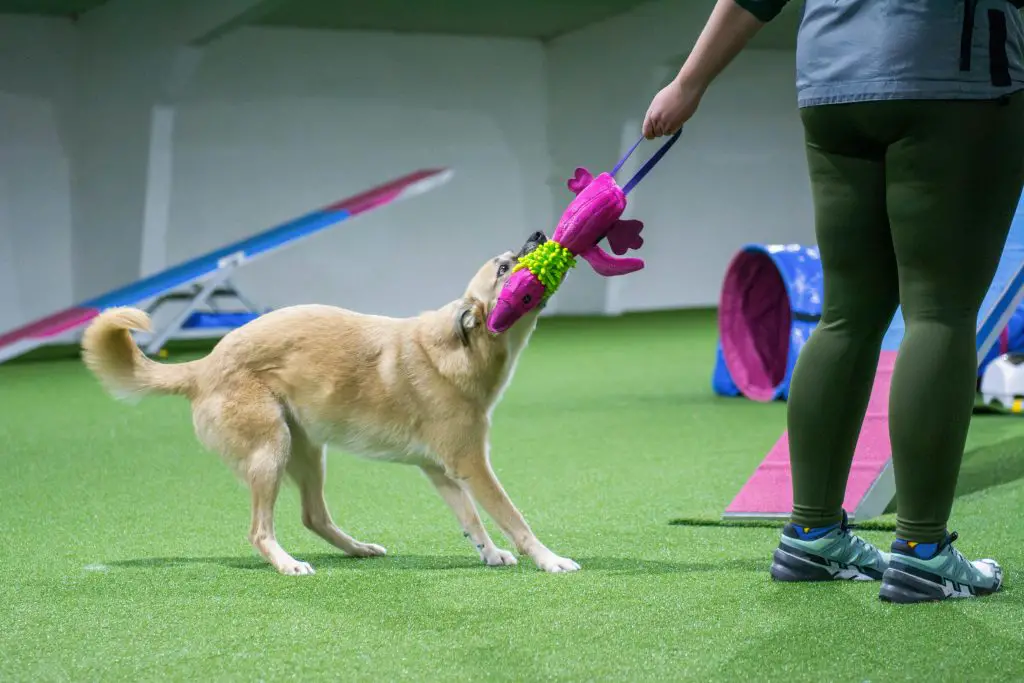
By setting aside regular times for training, you’re building trust and enhancing communication skills with your dog, making it easier for them to grasp the ‘Quiet’ command.
To start, follow these steps:
- Set a Routine: Schedule training sessions at the same time each day. Consistency reinforces learning and helps your dog anticipate training times, making them more receptive.
- Short and Focused Sessions: Keep each session around 10-15 minutes. Short, frequent sessions are more effective than long, sporadic ones, as they prevent your dog from becoming overwhelmed and help retain their attention.
- Clear Commands and Cues: Use the same word and hand signal every time you give the ‘Quiet’ command. Consistent terminology helps your dog associate the command with the desired behavior, ensuring clarity and reducing confusion.
Use Positive Reinforcement Techniques
Implementing positive reinforcement techniques is crucial for effectively teaching your dog the ‘Quiet’ command. Start by using clicker training, a method that marks the exact moment your dog stops barking.
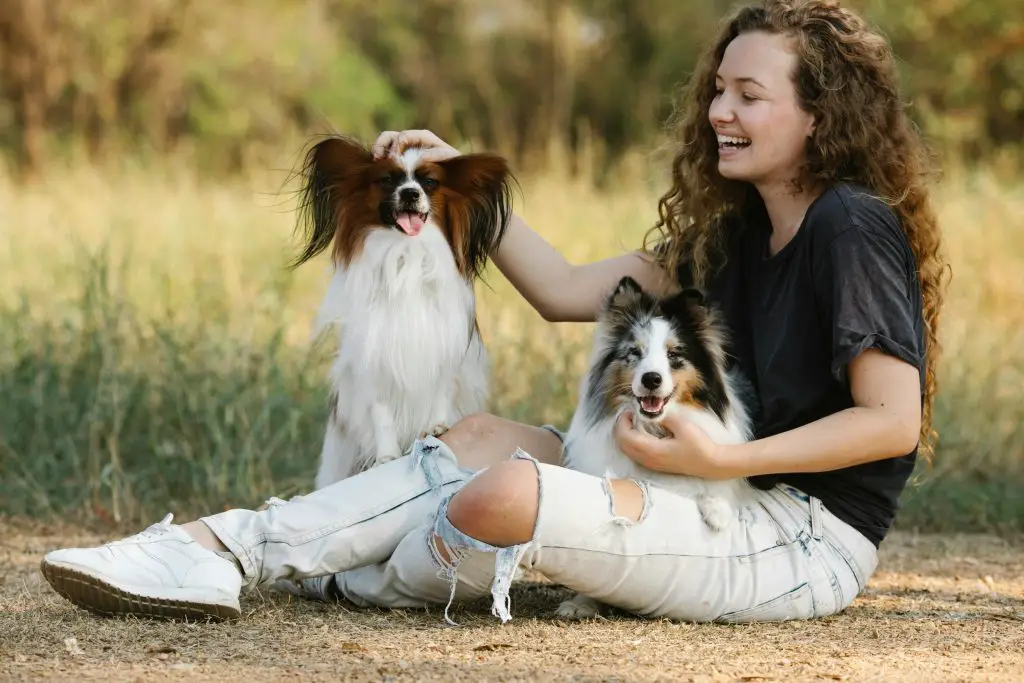
As soon as your dog pauses, click the device and immediately follow up with treat rewards. This combination reinforces the desired behavior, making it clear to your dog that being quiet leads to positive outcomes.
Begin your training sessions in a controlled setting where distractions are minimal. When your dog starts barking, say ‘Quiet’ in a calm, firm voice. The moment your dog stops, click and reward.
Consistency is key; repetition helps your dog understand the connection between the command, the action, and the reward. Incorporate play therapy to make training enjoyable and reduce stress.
Engage your dog in activities they enjoy after a successful training session. This not only serves as a reward but also promotes behavior modification by associating the ‘Quiet’ command with positive experiences.
Over time, gradually introduce more challenging environments, maintaining the same steps to guarantee your dog can generalize the behavior. With patience and persistence, your dog will learn to respond to the ‘Quiet’ command reliably.
Use Positive Reinforcement
Positive reinforcement, like rewards and praise, is a powerful tool to encourage your dog’s calm behavior. Begin with clicker training and treats.
Trending in Dogs:

Click and treat when your dog stays calm around people to form a clear link between the behavior and the reward.
For another effective approach, try play-based training. Engage your dog in their favorite game when they exhibit calm behavior.
Whether it’s fetch or tug-of-war, pair the play with enthusiastic praise to reinforce their good behavior.
Implement positive reinforcement with these steps:
1. Clicker Training with Treat Rewards
- Keep a clicker and treats handy.
- Click and treat when your dog is calm.
- Consistently repeat to reinforce the behavior.
2. Play-Based Training with Praise Reinforcement
- Reward calm behavior with play.
- Match play with immediate and excited verbal praise.
3. Stay Consistent and Patient
- Stick to your training routine.
- Practice daily and be patient with progress.
Manage the Environment
Creating a serene environment is vital to helping your dog stop barking at people. Begin by removing any stressors that might trigger your dog’s barking.

Close curtains or blinds to limit visual stimuli. If your dog reacts to noises, consider using white noise machines or calming music to mask outside sounds.
Next, create an enriching environment within your home. Provide toys, puzzles, and interactive feeders to keep your dog mentally engaged and less focused on external distractions.
Regular exercise is essential; a tired dog is less likely to bark out of boredom or frustration.
Implementing behavior modification techniques can also help manage your dog’s environment. Establish a quiet zone where your dog can retreat when feeling overwhelmed.
This space should be away from high-traffic areas and equipped with comfortable bedding and favorite toys.
Consistency is key. Reinforce calm behavior by rewarding your dog when it’s quiet, using treats or praise.
Avoid inadvertently encouraging barking by giving attention during outbursts. Instead, wait for a moment of silence before responding.
Desensitize to People
To desensitize your dog to people, start with controlled social interactions in a calm environment. Use gradual exposure techniques by introducing your dog to people from a distance, slowly decreasing the distance over time.
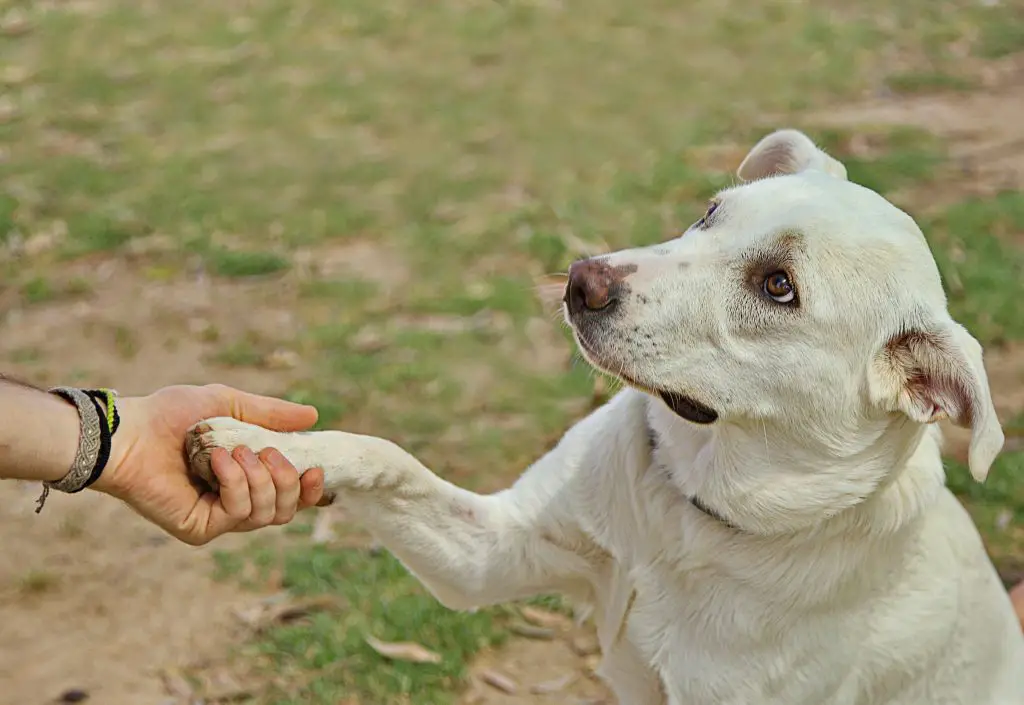
Always reward your dog for calm behavior to reinforce positive associations with new people.
Controlled Social Interactions
Gradually introducing your dog to controlled social interactions with people can help reduce excessive barking by desensitizing them to new faces.
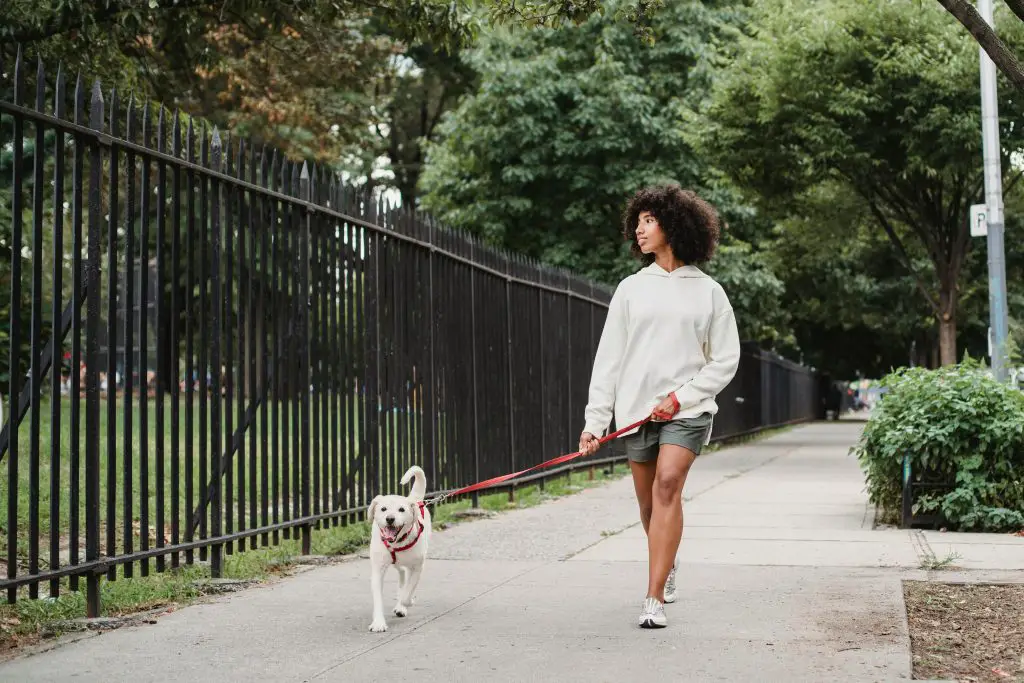
Behavior modification through controlled interactions can make your dog feel more comfortable around strangers.
Start by identifying triggers that cause your dog to bark, such as distance, appearance, or specific behaviors.
Create a controlled environment by having a friend or family member approach your dog slowly and calmly in a familiar setting. Keep these interactions short and positive, rewarding your dog for staying calm.
Gradually increase the number and variety of people your dog interacts with, ensuring each experience is positive and controlled. Use treats and praise to reinforce calm behavior during these interactions.
By taking these steps, you can help your dog adjust to new faces and reduce excessive barking.
Gradual Exposure Techniques
One effective method to desensitize your dog to people is through gradual exposure techniques. Start by identifying the distance at which your dog begins to bark at people.

This distance is your baseline for exposure therapy.
Position yourself and your dog at this baseline distance, ensuring they remain calm. Gradually decrease the distance over multiple sessions, always monitoring your dog’s comfort level.
Fear desensitization involves making these gradual introductions to people while maintaining a controlled environment. See also How to Stop Dog Separation Anxiety Effectively
Introduce one person at a time, ensuring they remain non-threatening and calm. The goal is to build your dog’s confidence by associating people with positive experiences.
Begin with the person standing still at a distance and then slowly have them move closer over time.
If your dog shows signs of stress or starts barking, increase the distance slightly and try again later. Consistency is key in confidence building.
Regular, controlled exposure will help your dog get used to the presence of people without feeling overwhelmed.
Patience and persistence will help your dog learn that not all people are a threat, ultimately reducing their barking behavior.
Rewards for Calm Behavior
Rewarding your dog for calm behavior is crucial in desensitizing them to people and reinforcing positive interactions.

When your dog stays calm around strangers, you create a strong association between people and positive experiences.
Here’s how you can effectively use rewards to encourage calm behavior:
- Clicker Training: Use a clicker to mark the exact moment your dog exhibits calm behavior. The clicker’s sound serves as a clear signal that they’re doing something right.
- Treat Dispensing: Equip yourself with a treat-dispensing tool or pouch for easy access. When your dog remains calm as a person approaches, dispense a treat promptly. This consistent reward helps your dog understand that staying calm brings positive outcomes.
- Gradual Reinforcement: Start in a low-distraction environment and gradually increase the level of distraction. Begin by rewarding calm behavior at a distance from people, then slowly decrease the distance as your dog becomes more comfortable.
This step-by-step approach ensures your dog isn’t overwhelmed and learns to stay calm in various scenarios.
Using these techniques, you’ll effectively desensitize your dog to people and reduce their barking.
Consistency and patience are key to success in this training process.
Redirect Attention
To effectively redirect your dog’s attention away from barking at people, use a favorite toy or treat to capture their focus.

This method of redirecting attention is a powerful training technique that can help modify your dog’s behavior. When your dog begins to bark, immediately present the diversion.
A toy or treat can shift their focus away from the trigger and onto something positive. Incorporating diversions techniques into your training routine is essential.
Consistently using a specific toy or treat can condition your dog to associate the diversion with a pleasant experience.
Over time, this behavior modification becomes more effective, reducing the frequency and intensity of barking. Here’s a simple table to help you choose the best diversions:
| Diversion Type | Example |
|---|---|
| Toys | Squeaky toy, chew toy |
| Treats | Small, high-value treats, kibble |
| Activities | Obedience commands, play session |
To maximize success, make sure that the toy or treat you use is something your dog genuinely enjoys. If they’re not interested, the diversion won’t be effective.
Timing is critical; introduce the diversion the moment barking begins.
Seek Professional Help
Occasionally, you might find it necessary to seek professional help when your dog’s barking behavior persists despite your training efforts.

Consulting a professional can provide valuable insights and effective strategies for behavior modification tailored to your dog’s specific needs.
Here’s how to proceed:
- Find a Certified Dog Trainer or Behaviorist: Look for professionals with certifications from reputable organizations like the Certification Council for Professional Dog Trainers (CCPDT) or the International Association of Animal Behavior Consultants (IAABC). These experts have the training and experience to address persistent barking issues.
- Schedule a Consultation: During the consultation, the professional will assess your dog’s behavior, identify triggers, and develop a customized behavior modification plan. They’ll provide you with professional guidance on implementing these strategies effectively.
- Follow Through with Consistency: Consistency is key in behavior modification. Make sure you adhere to the recommendations and techniques provided by the professional. Regularly update the trainer or behaviorist on your dog’s progress and adjust the plan as necessary.
Frequently Asked Questions

Training a dog to stop barking varies, typically taking weeks to months. It depends on your consistency and patience with training techniques.
The effectiveness increases as you maintain clear commands and positive reinforcement throughout the process.
Imagine the frustration! Yes, certain breeds do have tendencies to bark more. Effective training methods, socialization impact, and behavior modification can help manage this.
Understanding your dog’s breed tendencies is essential for successful training.
When training your dog, it is crucial to avoid using inconsistent commands and losing patience. Always focus on using positive reinforcement and steer clear of any distractions during training sessions. Consistency and patience play a vital role in achieving success as they help your dog understand and respond appropriately to your cues
Yes, you can train older dogs to stop barking at people. Use socialization techniques and behavioral modification. Focus on positive reinforcement and consistency in training – these methods help your dog learn and adapt more effectively.
Imagine a solution right in your hands! Interactive toys, treat dispensers, training collars, and ultrasonic devices can work wonders.
These tools keep your dog engaged and can effectively reduce barking, helping you regain peace and quiet.
Conclusion

Training your dog to stop barking at people is like sculpting a masterpiece; it requires patience and precision. By understanding triggers, socializing early, teaching the ‘Quiet’ command, using positive reinforcement, managing the environment, desensitizing to people, and redirecting attention, you’ll create a well-behaved companion.
If needed, don’t hesitate to seek professional help. With consistent effort, your dog will become a calm, quiet presence, making your shared lives more enjoyable.
Stay committed, and you’ll see results.



